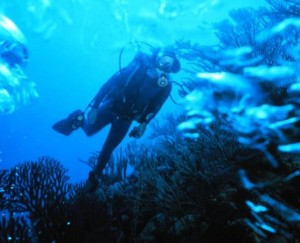The assisted-diving pioneer, Jacques Cousteau, identified the Aliwal Shoal as one of the best dive spots in the world. This is high praise from a trusted authority, and as a consequence, the shoal has enjoyed worldwide renown and attracted international and local divers for several decades (ever since the mid-twentieth century).
The coastal town of Umkomaas is the closest town to the dive spot, and is therefore well geared towards diving. There are, however, other scuba diving lodges in the general area, like Thonga beach lodge, that will also provide the adventure seeker with plenty of opportunities for great scuba diving.
Dive/boat tour operators in Umkomaas will transport divers the five kilometres from shore to shoal, and vice-versa, and will most often have equipment to rent. Their experience and knowledge of the area will serve inexperienced divers well, and even well-seasoned divers will benefit from using a tour company operating out of Umkomaas.
The Aliwal Shoal
As stated, the Aliwal Shoal is situated about 5km off the coast of Umkomaas in KwaZulu Natal. The shoal itself is actually a rocky reef (an underwater feature breaking the uniformity of the seabed that is 11m or less below sea level) formed from the remains of an ancient sand dune. Whereas the formation of the reef relied on abiotic oceanic forces, a variety of hard and soft corals grow on the underlying shallow substrate which in turn provides an aquatic environment suited towards supporting a multitude of subtropical and tropical fish species.
Along with the above mentioned fish species, the shoal is also a fertile ground for sighting Grey Nurse Sharks between August and November when the sharks converge on the area to mate. The grey nurse shark (affectionately known as “raggies” by South Africans) inhabits waters all over the globe. Typically, the shark is found in warmer waters and close to sandy beach shorelines. Despite the often times intimidating appearance of the shark (its ragged teeth, pointed head and bulky body), it is a relatively docile species that moves quite slowly through waters.
The ragged tooth shark grows to about 3m length (not at all a small shark) and hunts large schools of fish close to shore. Groups of raggies are known as “shivers”, and their diet consists mainly of bony fish, crustaceans, squid, and skates. Unfortunately, the species is listed as Vulnerable on conservation lists, which means that much needs to be done to ensure their continuing survival.
The shoal earned its name by nearly sinking the three-masted ship, the “Aliwal”, captained by James Anderson when the vessel was en route to Natal in 1849. Whereas the “Aliwal” escaped her fate, two other ships were not so lucky and have become the repossessed properties of the ocean. The Norwegian bulk carrier, the “Produce” ran aground in 1974, and the “Nebo” sank 90 years earlier in 1884. The two sunken vessels create a protected environment for aquatic life, and are prime targets for divers wanting to experience an underwater wreck. Another, rather unusual, wreck found in the area is a World War II plane (the Kitty Hawk) brought down over the coast.
If you’re planning to make a trip down to Umkomaas to dive the shoal, it is recommended that you use the dive centres in the area that are designed around providing tourists and locals with the best possible encounter of this underwater wonder.
